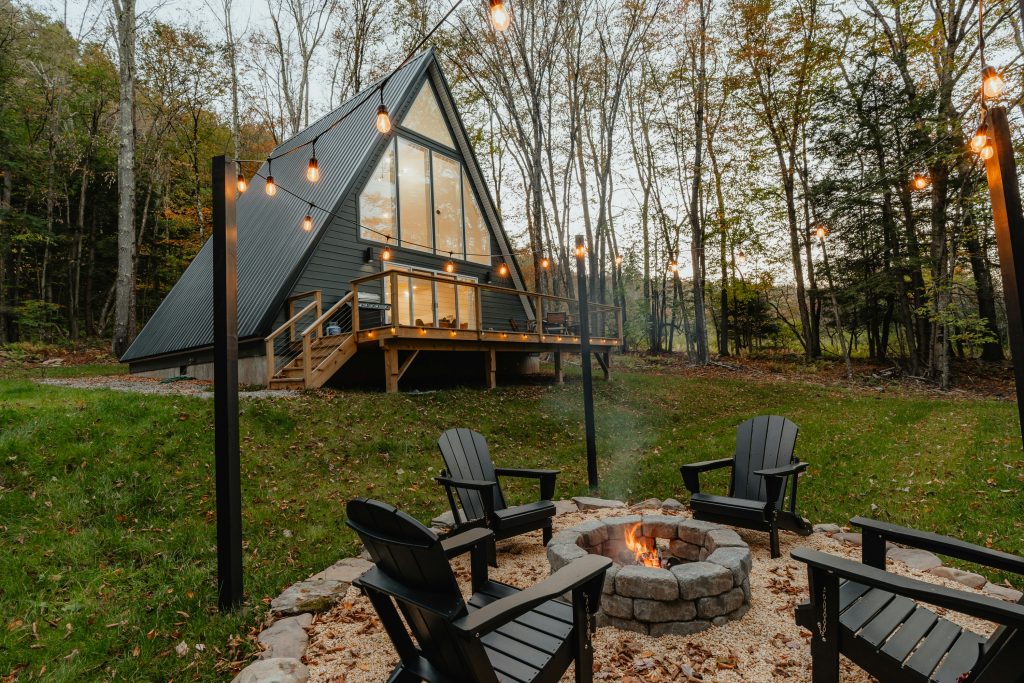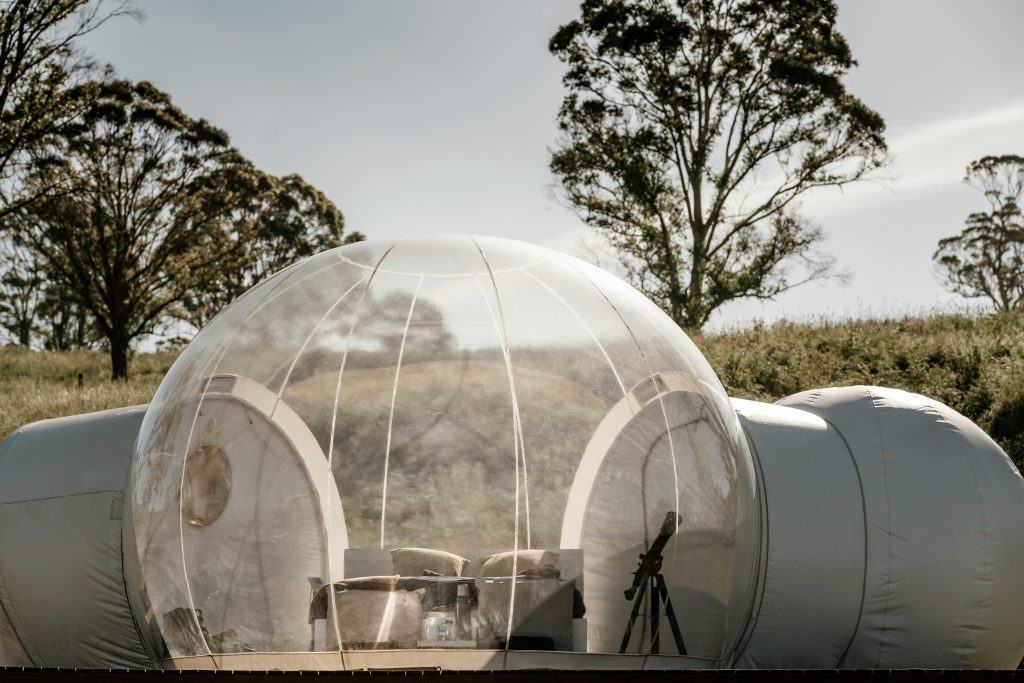The glamping industry has experienced remarkable growth over the past few years, with traveller interest in this luxurious alternative to camping reaching new heights. Glamping operators around the world continue to enjoy strong booking rates and generate impressive profits.
Hosting guests in cabins, pods, teepees and treehouses has never been a more promising business opportunity. But, as with all new ventures, starting a glamping business is challenging and poses some unexpected risks.
To help you take advantage of the ongoing glamping boom, we’ve created a guide that will take you through all the key steps of how to start a glamping business.
Whether you’re a small business owner getting into the accommodation industry for the first time or an experienced property manager looking to add glamping properties to your portfolio, we’ve got your back.
We even asked our friends at Quality Unearthed for actionable insight on what it takes to run a glamping business.
So let’s get right into it!

Are glamping businesses profitable?
Glamping businesses can be extremely profitable if you find the balance between having low expenses, high occupancy, while making use of dynamic pricing for your nightly rates.
Who is the target market for glamping?
The target market for glamping is getting broader and broader. According to the 2019 KOA report, 48% of glampers were Millenialls, 28% were Gen X, 12% were Gen Z, 9% were Baby Boomers and 3% were mature travellers. A 2024 found that while the 18-32 years age group dominates the glamping market, older audiences are growing. Glamping is especially popular among couples and families with children.
What makes a great glamping site?
A great glamping site is in an attractive location, ideally surrounded by nature, with access to outdoor attractions (like viewpoints and beaches) and activities (like hiking, cycling or kayaking). It’s a unique spot away from the hustle and bustle of big cities easily where travellers can relax. It also needs to be easily reachable by transport.
Why is glamping so popular?
The most important factor that drives the popularity of glamping is undoubtedly travellers’ desire to experience the outdoors and spend time in nature.
Prolonged covid lockdowns strengthened the need to escape from busy city life, and since then, glamping has seen a measurable surge in popularity. The rise of remote jobs and flexible working have made “workcations” increasingly popular, allowing people to combine work with nature-based experiences.
The latest North American camping report, published in 2022, shows that the outdoor hospitality sector has grown significantly, with around 11 million more households participating in camping activities in 2024 compared with 2019. It is estimated that about 17 million households took at least one glamping trip in 2021, a 155% increase from 2019, and of those who have glamped, 74% plan to glamp again in the near future.
Cabins & pods accounted for a revenue share of over 38% in 2024, reflecting the continued preference for comfortable, nature-integrated accommodations.
The global glamping market size was valued at USD 3.52 billion in 2023 and is projected to reach USD 9.23 billion by 2031, with a compound annual growth rate (CAGR) of 12.80% during this period..
To capture the growing demand, more and more businesses around the world are investing in glamping sites. Simultaneously, booking platforms where travellers can book glamping-style accommodations are springing up – and drawing the attention of investors.
If this sounds like an opportunity you don’t want to miss, take a look at our step-by-step guide to starting up your own glamping business, and get in on the action!

5 steps to building a glamping business
If you want a slice of the glamping cake, now’s the time to get started.
Whether you’re starting from scratch, or adding glamping properties to your existing vacation rental portfolio, here are the steps to take–with insider tips from Thom James, Marketing, Operations and Owners Team Manager at Quality Unearthed–an agency that manages over 200 unique glamping properties in the UK.
1. Find a location for your glamping site
Scouting locations is a good place to start, as this will determine your opportunities and constraints. The ideal place to set up a glamping site is one that’s surrounded by nature (and outdoor activities like hiking, biking and kayaking) but can be easily accessed by transportation.
“Many of the owners we deal with use surplus land or buy plots of land with the intention of turning it into a space where they can start a glamping site. We are also seeing a sizable number of owners diversify current land, such as farms and agricultural land into second-use spaces for glamping sites,” said Thom.
Speaking of “repurposing” pieces of land, many glamping property managers decide to partner with landowners through a revenue share model and install glamping units on their properties.
“This can be a viable way of securing land without the need to purchase expensive bits of real estate, but you have to do your homework. Often, you need to agree on who provides not only the service but also the utilities for making the site a viable destination, suitable for people to stay at,” Thom said.
“It’s not just about the share of revenue that dictates this; you need a proper consultation process where each interested party knows and understands what they are responsible for” he added.
2. Choose your glamping property type
There are so many fun and unique glamping property types, it’s hard to choose. Instead of relying on your intuition, it may be worth looking at what’s popular among travellers.
A recent KOA report found that 42% of travellers seek cabins when searching for glamping accommodation, while 14% seek treehouses, 10% yurts, 9% tiny homes, 9% on-site RVs, 7% safari tents, 3% covered wagons and 3% teepees.
According to the Grand View Research 2024 Global Glamping Market Report, the best best-performing accommodation types are glamping pods and bell tents, while treehouses, tiny houses and cabins also enjoying significant success.

“Treehouse structures are still by far the most desired type of structure, but there is huge merit in the uniqueness and quirkiness of an abode, too,” said Thom.
What’s most important is that you make the most of the land you’ve chosen and create something unique that travellers will not have seen before.
“Special and distinctive structures capture the imagination and can be lucrative for site owners, so anything out of the ordinary continues to capture the attention of the seasoned glamping audience. Also, think about your facilities. Hot tubs and outdoor baths or showers are also very popular right now,” he added.
3. Obtain the necessary permits and licences
Once you’ve found the perfect piece of land for your glamping site and decided on your chosen property type, it’s time to ensure legal compliance.
The type of permissions and licences you’ll need depends on a lot of different factors, like the number and type of units you plan to build and the facilities you plan to provide. There are also country-specific requirements, so be sure to check with your local authorities.
U.S. glamping regulations:
Starting a glamping site in the U.S. typically requires zoning approval and permits at the county or municipal level, especially if you’re changing land use or installing structures like tents, yurts, restrooms, or utility hookups.
Requirements vary depending on the state you’re planning to set the business. Note that generally, local governments often assess environmental impact, traffic access, wastewater systems, fire safety, and density regulations.
Take in mind that you may also need building permits, health department inspections, and business licenses, depending on your setup. Needless to say the potential risks you face by operating without the right permissions, involve fines or shutdown orders. We recommend you to always check with your local planning or zoning department — and consider working with a land-use consultant familiar with outdoor hospitality.
UK glamping regulations:
Running a glamping site in the UK usually requires planning permission due to two main factors: changing the land’s use (if operating more than 28 days a year) and installing temporary or permanent structures like pods, toilets, or utility connections.
Local authorities will assess environmental impact, site density, access, waste management, and fire safety. Depending on your setup, you may also need building regs approval, food safety licensing, and tourism-related permits. Operating without permission can lead to fines or shutdowns, so always consult your local planning authority and consider hiring a planning consultant to ensure full compliance. This is why we recommend you to check with the local government before you plan to set up a camping or glamping business.
Canadian glamping regulations:
In Canada, launching a glamping business typically requires municipal zoning approval and provincial permits, particularly if your operation changes how the land is used or adds permanent or semi-permanent structures like domes, washroom facilities, or utility connections. Local authorities will review land use bylaws, septic and waste systems, fire access, and any environmental considerations.
You may also need to meet building code requirements, obtain public health approvals (especially if serving food), and register for tourism-related licences. Skipping the paperwork can cost you big—fines, shutdowns, or worse. Check in with your local municipality or provincial ministry before you break ground to make sure your glamping site is fully greenlit.
4. Create an operational plan
Before you get into glamping, it’s crucial to understand the unique operational needs of glamping units, which are vastly different from those of traditional vacation rentals.
The unique operational needs of glamping units are vastly different from those of traditional vacation rentals. Running a glamping business is like spinning plates while juggling flaming torches. You’re constantly switching between marketing your unique outdoor experience, fielding endless guest questions about everything from “Do the tents have heating?” to “Are there bears nearby?”, managing multiple booking platforms, processing payments, and somehow finding time to actually maintain your beautiful outdoor spaces can become stressful.
The real challenge hits when you’re trying to handle new inquiries while current guests need assistance with their campfire or can’t figure out the outdoor shower. Add in the constant cycle of cleaning, sanitizing, check-outs, and check-ins — all while being the on-site problem solver for any outdoor adventure mishaps — and you’ll quickly realize why many glamping operators feel overwhelmed.
Smart tools can help you handle this without the hustle But if you’re determined to manage your own glamping empire, you’ll need rock-solid technology and streamlined systems to keep your sanity intact while delivering those magical outdoor experiences your guests are paying premium prices for.
5. Use the right technology
Vacation rental technology has come a long way in the last decade.
Every vacation rental owner can benefit from sophisticated technology solutions through agencies like Quality Unearthed who have robust, integrated tech stacks designed to maximize efficiency and minimize the risk of human error in both operations and marketing.
However, if you’re planning to manage your own glamping properties, you’ll need to find these solutions yourself.
Firstly, you’ll want to work with a PMS like Anytime Booking or Elite Dynamics: both of which have extensive experience in the outdoor rental industry and specialize in managing outdoor accommodations like holiday parks and glamping sites.
Secondly, you’ll need a channel manager like Rentals United that allows you to connect to 90+ OTAs, including a healthy assortment of large platforms like Airbnb, Booking.com, Vrbo and Tripadvisor, as well as niche sites like Glamping Hub that cater specifically to your nature-seeking clients.
Using a channel manager allows you to manage multiple listings across all your chosen channels simultaneously, through a single, unified inbox.

With Rentals United, you can connect to major OTAs like Airbnb, Booking.com and Expedia, all of which are popular among travellers searching for glamping properties.
You can also get listed on vacation rental metasearch engines like Holidu and HomeToGo where travellers go to compare deals, as well as Google where millions of travellers search for accommodations every day.
To maximize reach we have the strongest connections to niche websites like Glamping Hub where adventurous travellers search specifically for glamping-style accommodation.
With its large variety of channels and high-quality API connections, Rentals United can help you expand your reach, attract travellers from all over the world to your glamping site and incrementally increase your bookings.
Ready to kickstart your glamping business in 2025?
We hope this guide helps you get started with planning your glamping business. Let’s recap the advice above:
- Find a location that’s close to nature and easily accessible. Decide if you want to purchase a piece of land, reuse existing land or partner with landowners.
- Choose a glamping property type that’s popular with travellers. Remember that each property type has different startup and maintenance costs and, as a result, will provide a different ROI.
- Obtain the necessary permits and licenses. Check with your local authorities to make sure you’re ticking all the legal boxes.
- Create a plan. Spend time on the operations sections of your business plan and make sure you understand the unique needs of glamping units.
- Use specialized technology. Choose a channel manager like Rentals United that allows you to advertise on a variety of booking channels – from OTAs to niche glamping sites – and integrates with specialist PMS providers.
Are you ready to start attracting travellers to your glamping properties? See how our channel manager can help you maximise your reach and revenue.